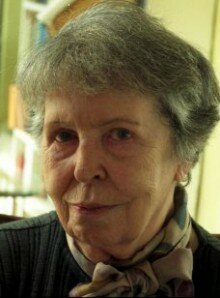
Máire Mhac an tSaoi was born in Dublin in 1922. Her father, Seán MacEntee, a native of Belfast, was a prominent politician who had served in the 1916 rising against British rule in Ireland. Her mother was a teacher and scholar. Her uncle, Monsignor Pádraig de Brún, was a distinguished and influential schlolar of the Irish language. From the age of two she spent up to five months a year in his house in Dún Chaoin, in the heart of the Munster Gaeltacht, or Irish-speaking area, so that, the poet says, she can never remember a time when she was not bilingual. Her debut collection of poetry was published to acclaim in 1956 and subsequent volumes established her as a unique and revolutionary voice in Irish-language poetry.
Before she had ever published a book, Daniel Corkery, whose presence, according to Seán Ó Riordáin, whose presence even popes night enter apprehensively lest they be found wanting, had delivered a positive verdict on Máire Mhac an tSaoi’s work. In a 1953 essay on the poem ‘Inquisitip 1954’, he noted with approval the author’s technical accomplishment, he familiarity with tradition, and the graceful simplicity of her language. Three years later in his Christmas round-up of recent collections, Seán Mac Réamoinn declared her first collection, Margadh na Saoire, the most notable book in Irish for 1956, ‘for the strength of her talent, her artistic ability, and complete mastery of the Irish language. That mastery is in my view, the most notable feature of her work’.
In the Irish Times John Jordan was even more effusive, declaring her ambitious long poem, 'Ceathrúintí Mháire Ní Ógáin' ['Mary Hogan's Quatrains'] as “unquestionably the finest sequence of its kind written in Irish since the efforts to create in the revived language began… She is a prober of the condition of love, and no living Irish poet has brought more honesty and insight to the subject”.
Seán Ó Tuama’s review in Feasta was more sceptical. While acknowledging that there was a degree of conviction throughout the book and a fierce commitment to the native tradition, he argued that the collective voice of tradition tended to surpress her individual insight. Nonetheless, he applauded the humanity and integrity of feeling in a number of the shorter poems, identifying human relationships and her relationship with place as her primary preoccupations. Some thirty years later, in a 1984 interview, the poet remembered her debut collection as containing work written over almost twenty years, including ‘Oiche Nollag’, which she wrote at the age of fifteen.
The centerpiece of Margadh na Saoire is 'Ceathrúintí Mháire Ní Ógáin', in which the poet adopts the persona of Mary Hogan, a woman afflicted by impossible love and unable to free herself from a destructive relationship. In folk tradition the name of Máire Ní Ógáin, who was reputedly the mistress of Donnchadh Rua Mac Con Mara, was a byword for female folly. John Jordan described the poem as an ‘anatomy of passion’, in which ‘Crazy Jane and the Hag of Beare come together, and the resultant utterance is contemporary and timeless’. More than half a century after it was first published, the declaration of female desire in 'Ceathrúintí Mháire Ní Ógáin' maintains its transgressive force, careless of social and religious censure:
I care little for people’s suspicions,
I care little for priests’ prohibitions,
For anything save to be stretched
Between you and the wall-
I am indifferent to the night’s cold,
I am indifferent to the squall or rain,
When in this warm narrow secret world
Which does not go beyond the edge of the bed-
A generation before the groundbreaking achievements of Eavan Boland, Nuala Ní Dhomhnaill, Biddy Jenkinson, Medbh McGuckian, Eiléan Ní Chuilleanáin, Rita Ann Higgins, and others, and in more daunting social circumstances, Máire Mhac an tSaoi’s poetry speaks to and from the intimate experience of women at a time when women’s voices were largely inaudible, on the margins of Irish literature and society. This bilingual selection of her work is the first substantial collection to introduce her work to an English-language audience and a reminder to readers of Irish why she is one of the most significant poets to emerge since the beginning of the language revival almost a century and a half ago.
Select bibliography
Poetry
Margadh na Saoire, Sáirséal agus Dill, Dublin, 1956
Codladh an Ghaiscígh agus Véarsaí Eile, Sáirséal agus Dill, Dublin, 1973
An Galar Dubhach, Sáirséal agus Dill, Dublin,1980
An Cion go dtí Seo, Sáirséal Ó Maircaigh, Dublin, 1987
Shoa agus Danta Eile, Sáirséal Ó Marcaigh, 1999
The Miraculous Parish / An Paróiste Míorúilteach, O'Brien Press / Cló Iar-Chonnachta, 2011
Autobiography
The Same Age as the State, O'Brien Press, Dublin, 2004
Links
Mhac an tSaoi at the National University of Ireland, Galway
Mhac an tSaoi at O'Brien Press

